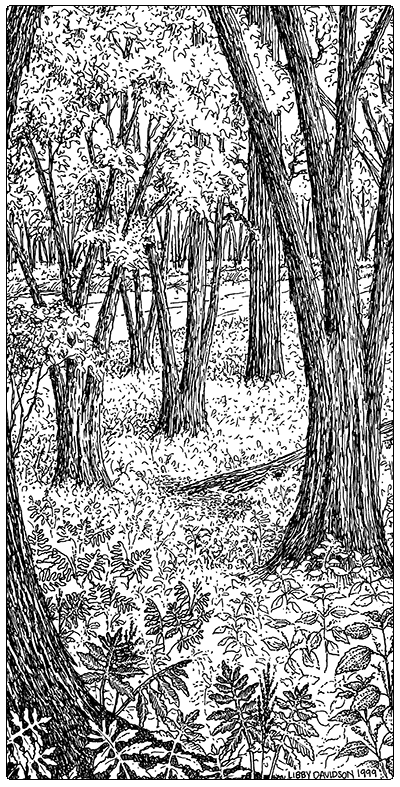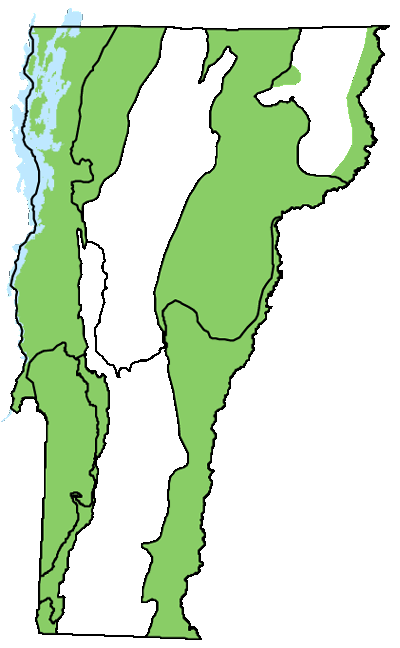Ecology and Physical Setting 
This is Vermont’s wettest riverine floodplain forest type. It occurs on floodplains adjacent to the lower gradient portions of our larger rivers, often behind the natural levee. These forests receive annual overbank flooding from the river, in some cases in both the spring and fall. Long after water has drained from the elevated, coarse soils of the ostrich fern-dominated levees, these areas remain flooded. The soils are alluvial, generally with a silt loam texture, although clay loam and very fine sandy loam soils are also encountered. Most soils have mottling within the upper four inches of the soil surface, owing to the fine soil texture and the relatively long duration of flooding. There is no surface organic layer as the leaf litter decomposes quickly and mixes with new alluvium. This floodplain forest type is always considered a wetland.
Vegetation
The towering trunks and high, arching branches of silver maple form a dense canopy. In mature forests, such as those that occur on the deltas of the Lamoille and Missisquoi Rivers, silver maples reach diameters of nearly four feet, heights of over 100 feet, and ages up to 150 years. Green ash, most common in the Champlain Valley, is abundant at some sites. American elm, once a dominant, is also a common canopy associate, although most large individuals of this species are now dead or dying. Swamp white oak is less common.
Shrubs are generally sparse, although winterberry holly may be abundant in patches. Saplings and seedlings of silver maple, green ash, and swamp white oak are often present but are seldom abundant. Sensitive fern is the dominant herb, often forming a nearly complete ground cover with other herbs interspersed in low abundance. Wood nettle is abundant in patches at some sites and absent from others, whereas false nettle is seldom dominant but is almost always present. Other herbaceous plants include marsh fern and whitegrass.
Wildlife Habitat
Silver Maple-Sensitive Fern Floodplain Forests occur in larger patches and are wetter than other riverine floodplain forest types. They are most common in the Champlain Valley at the lower stretches of our larger rivers. These characteristics influence the wildlife habitat they provide. Spring peepers and northern leopard frogs may be abundant in backwater pools and open canopy areas, respectively. Breeding migratory birds include great crested flycatcher, warbling vireo, yellow-throated vireo, and American redstart. Common goldeneye is a cavity-nesting duck that is a rare breeder in Vermont, with its primary breeding range to the north. It is sensitive to human disturbance and takes advantage of the larger floodplains at the mouths of the Lamoille and Missisquoi Rivers. Green heron and the rare black-crowned night heron both may be found nesting in trees in these floodplains and hunting for prey in nearby marshes or along the edge of the river. The enormous silver maples found in mature forests have large flakes of peeling bark that provide important day-time roosting sites for the federally endangered Indiana bat.
Related Communities

- Silver Maple-Ostrich Fern Floodplain Forest is distinguished by an abundance of ostrich fern, shorter duration flooding, and better-drained, coarser-textured soils.
- Lakeside Floodplain Forests are very similar in vegetation but are found along Lake Champlain and Lake Memphremagog. Herbs are sparse. They differ in having soils that receive little alluvium during annual flooding and consequently have a well-developed surface organic layer. They also differ in having a longer duration of spring flooding.
Conservation Status and Management Considerations
As with other types of riverine floodplain forests, Silver Maple-Sensitive Fern Floodplain Forests have been largely converted to agricultural use. However, some high-quality examples remain, especially on the deltas where our larger rivers flow into Lake Champlain. Non-native invasive plants are a threat to this community type.
Distribution/Abundance
Silver Maple-Sensitive Fern Floodplain Forests occur throughout New England, New York, Pennsylvania, Québec, and Ontario. In Vermont, they occur on the lower gradient portions of our larger rivers, including deltas. There are few large examples of this community remaining throughout its range.
Characteristic Plants
Trees
Abundant Species
Silver maple – Acer saccharinum
Green ash – Fraxinus pennsylvanica
Occasional to Locally Abundant Species
American elm – Ulmus americana
Swamp white oak – Quercus bicolor
Shrubs and Vines
Occasional to Locally Abundant Species
Winterberry holly – Ilex verticillata
Poison ivy – Toxicodendron radicans
Riverbank grape – Vitis riparia
Herbs
Abundant Species
Sensitive fern – Onoclea sensibilis
Occasional to Locally Abundant Species
Wood nettle – Laportea canadensis
False nettle – Boehmeria cylindrica
Marsh fern – Thelypteris palustris
Whitegrass – Leersia virginica
Spotted touch-me-not – Impatiens capensis
Swamp candles – Lysimachia terrestris
Northern bugleweed – Lycopus uniflorus
Fringed sedge – Carex crinita
Groundnut – Apios americana
Hop sedge – Carex lupulina
Common beggar’s-ticks – Bidens frondosa
Virginia wild rye – Elymus virginicus
Jack-in-the-pulpit – Arisaema triphyllum
Hog peanut – Amphicarpaea bracteata
Mad-dog skullcap – Scutellaria lateriflora
Stout woodreed – Cinna arundinacea
Non-native Invasive Plants
Moneywort – Lysimachia nummularia
Dame’s rocket – Hesperis matronalis
Common buckthorn – Rhamnus cathartica
European spindle-tree – Euonymus europaeus
Rare and Uncommon Plants
Green dragon – Arisaema dracontium
Gray’s sedge – Carex grayi
Associated Animals
Spring peeper – Pseudacris crucifer
Northern leopard frog – Lithobates pipiens
River otter – Lontra canadensis
Mink – Neovison vison
Raccoon – Procyon lotor
American beaver – Castor canadensis
Eastern wood pewee – Contopus virens
Great crested flycatcher – Myiarchus crinitus
Warbling vireo – Vireo gilvus
Yellow-throated vireo – Vireo flavifrons
Veery – Catharus fuscescens
Yellow warbler – Setophaga petechia
American redstart – Setophaga ruticilla
Baltimore oriole – Icterus galbula
Wood duck – Aix sponsa
Hooded merganser – Lophodytes cucullatus
Common merganser – Mergus merganser
Pileated woodpecker – Dryocopus pileatus
Great blue heron – Ardea herodias
Green heron – Butorides virescens
Ebony jewelwing – Calopteryx maculata
Twelve-spotted tiger beetle – Cicindela duodecimguttata
Rare and Uncommon Animals
Wood turtle – Glyptemys insculpta
Indiana bat – Myotis sodalis
Red-shouldered hawk – Buteo lineatus
Blue-gray gnatcatcher – Polioptila caerulea
Osprey – Pandion haliaetus
Black-crowned night-heron – Nycticorax nycticorax
Common Goldeneye – Bucephala clangula
Places to Visit
Missisquoi River Delta, Swanton and Highgate, Missisquoi National Wildlife Refuge
Halfmoon Cove Wildlife Management Area, Colchester, Vermont Fish and Wildlife Department (VFWD)
Derway Island, Burlington, Winooski Valley Park District
Lamoille River Delta, Milton and Colchester, Sandbar Wildlife Management Area, VFWD
Rock River Wildlife Management Area, Highgate, VFWD
LaPlatte River Marsh Natural Area, Shelburne, The Nature Conservancy
